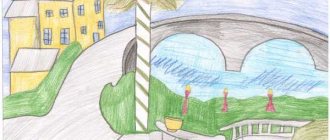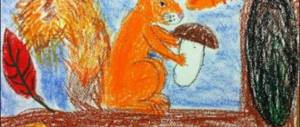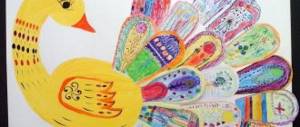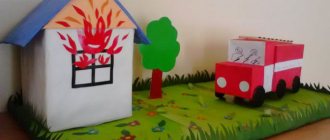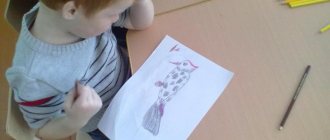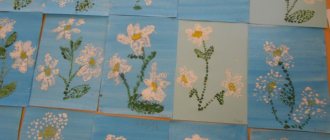Motivating start to a lesson on the topic “Our City”
Drawing inanimate objects (buildings, trees, fences) can weaken students' interest in visual arts. The initial stage of classes on the topic “City” should be the creation of a game situation with subsequent involvement in the creative process. Also, the imagination and desire to create are activated by holding a conversation based on the discussion of the children’s personal experience and figurative memory, joint study of visual material, listening to poems and excerpts from prose works containing descriptions of city landscapes.
Examples of using motivational materials
| Lesson topic | Motivating start |
| "City in the evening" | The guys are in the playroom. The teacher shows them toy birds and nests with straws. Conducting a conversation: at what time of the day are birds active (during the day), when do they wake up (at sunrise), and when do they fall asleep (at sunset). The lesson is held in the winter season, the teacher draws the children’s attention to the fact that it is already dark outside and it’s time for the birds to sleep, and offers to put the birds in their nests. The teacher takes the children to the window and draws attention to how beautifully the shadows lie on the snow-covered paths, how brightly the lanterns shine and how beautiful the multi-colored windows of the houses are. The children are given the task of drawing a winter city in the evening in order to share these beautiful moments with the birds tomorrow morning. |
| "Holiday City" | Conducting a conversation with parallel viewing of slides on a projector. The teacher instructs the children to imagine that they have all turned into tourists - residents of other cities - and have never been here before. What would they like to see in the city for the first time? The main square, museum, theater, Kremlin, cathedrals, etc. - viewing and studying slides. The teacher reminds the children that soon there will be fireworks in the city (for Victory Day or City Day). What time of day do fireworks go off? What color does it come in? What shape? Separately, it is necessary to discuss how the city will dress up for the holiday: flower beds will be planted, flags will be hung, posters and banners with congratulations will be placed on buildings. Pupils-tourists are given the task of taking photographs of the festive city as a souvenir - to draw a decorated street during the day or during fireworks. |
| "Autumn in the City" | Reading (with musical accompaniment) and discussion of poems about autumn: how the landscape changes, what colors predominate in the sky, what colors prevail in the plant world. Reasoning about what an autumn landscape might be like (gray in rainy weather, bright in sunny weather). The children are given the task of painting a corner of the city in autumn (the color palette is chosen to suit their taste - nature has no bad weather) in order to arrange an exhibition of works in the hall for the Autumn Festival in the kindergarten. |
Compilation of notes on the topic “City”
The purpose of drawing classes on this topic is to create urban (rural) landscapes in various time, weather and situational conditions. A drawing lesson in the preparatory group of a kindergarten should last no more than 30 minutes and consists of the following stages:
- Organizational moment 1–2 minutes.
- Motivating start 6-7 minutes.
- Practical work 15–17 minutes.
- Demonstration and analysis of finished work 2–3 minutes.
- Summing up 1 minute.
The teacher needs to draw up a detailed plan for each lesson, followed by mandatory analysis: whether the set goals and objectives were achieved, whether the teaching methods and techniques used were effective, how the children behaved at various stages of the lesson, analysis of the students’ work, approximate ways to improve the lesson.
Summary of direct educational activities in drawing in the preparatory group on the topic “Evening City”. Author: Molochnikova A.I.
| Tasks | Activating interest in visual arts. Development of color and spatial perception. Strengthening the ability to construct a composition. |
| Materials | Looking at postcards and albums with photographs (possibly illustrations by artists) of the city. |
| Preliminary work | Sheets of paper, wax pencils, images of city landscapes in the evening. |
| Progress of the lesson | Artistic word: reading of Tatyana Zhivava’s poem “There is a special charm in big cities...” followed by a conversation. Study of illustrative material. The teacher creates a playful moment: he invites the children to try themselves as magic artists and draw the city in the evening. Discussion of the practical implementation of the task (how you can arrange objects on the sheet, what colors to use, etc.). Conducting physical education with musical accompaniment. Independent completion of the practical part by students. Demonstration of finished works, encouragement of the most beautiful drawings, gratitude to everyone for the work done. Summing up the lesson, assessment, cleaning of workplaces. |
